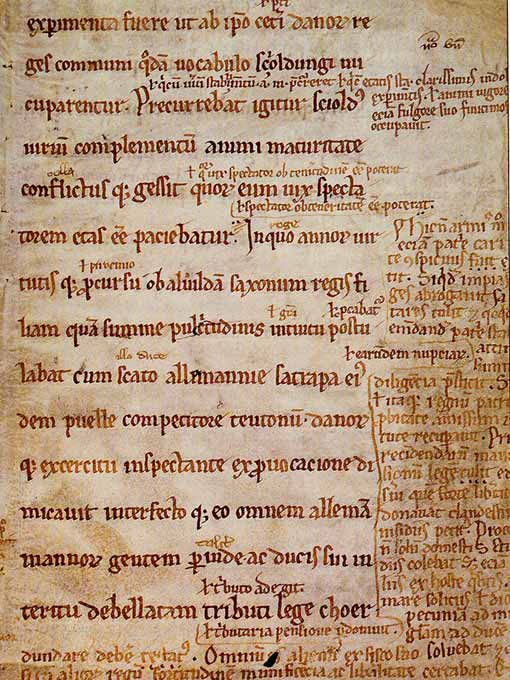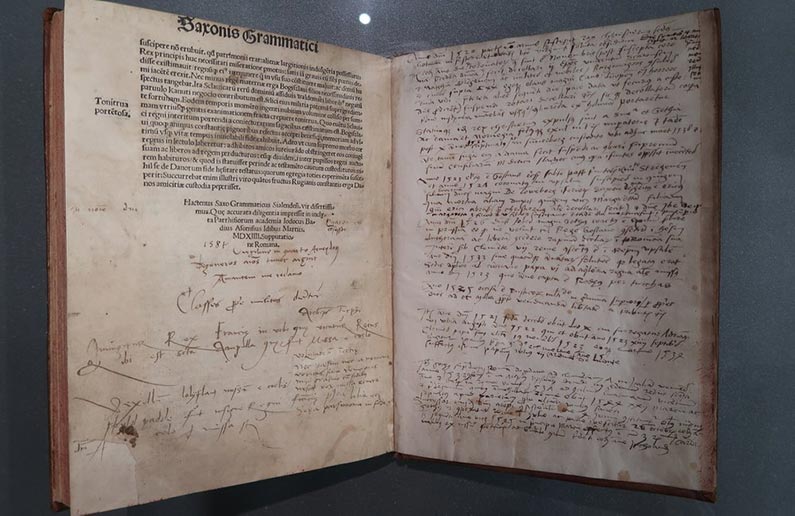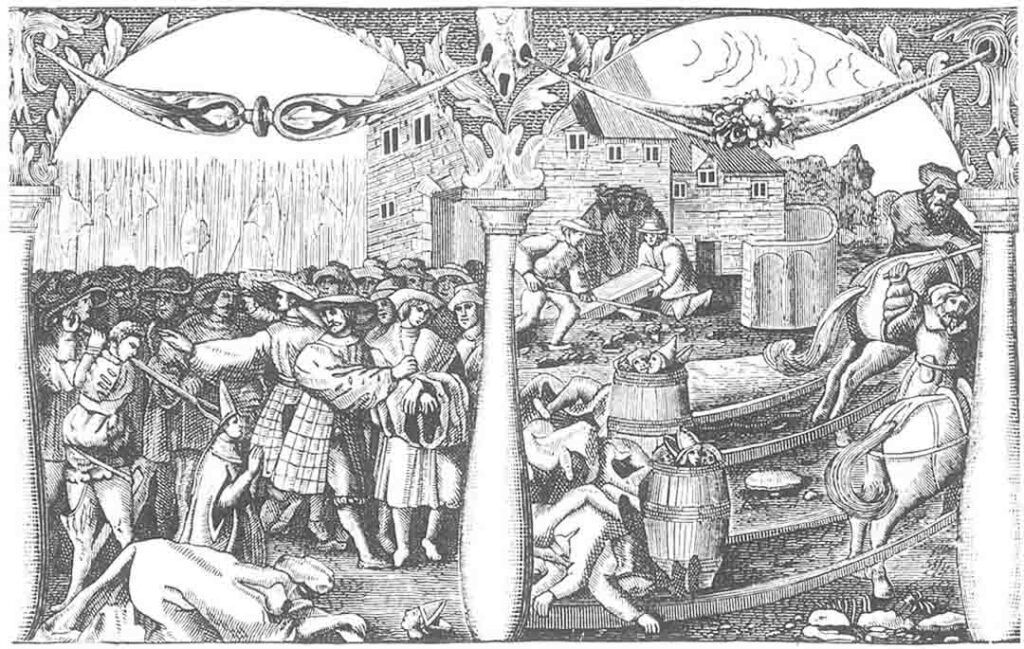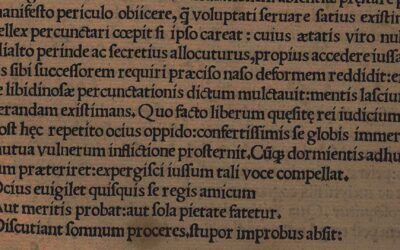Contents
In March 2018 Kungliga biblioteket, i.e. The Swedish Royal Library, bought a book for 2 million Swedish crowns – that is roughly 180.000 euro or 220.000 dollar. Later on the book was on display for three short days. Latinitium was there to get a glimpse.
(You can find a video in Latin here on our membership plattform Patreon.)
So what is this all about?! Why buy a book for that ridiculous amount of money?
The book in question was a copy of one of the most important sources to old Scandinavian, especially Danish, history, a book called Gesta Danorum.
Gesta Danorum, or Danorum Regum heroumque Historiae stilo eleganti a Saxone Grammatico natione Sialandico necnon Roskildensis ecclesiae praeposito, abhinc supra trecentos annos conscriptae et nunc primum literaria serie illustratae tersissimeque impressae, as the full impressive title reads, was written in the late 12th century and beginning of the 13th.
Who Was Saxo Grammaticus?
The author, Saxo Grammaticus, (Saxo the Learned) has been called the father of Danish history writing, and lived ca 1150–1220. We know very little about him and what we do know are what he lets us know himself via his book.
His father and his grandfather both served in Valdemar the Great’s army, but instead of becoming a military himself, Saxo was given the task by the Archbishop Absalon of Lund (then a Danish town, now a Swedish one) to write the history of Denmark to match the histories of other nations and make Denmark a nation with authority, stardom and depth.
Saxo might have been a clerk at the Cathedral of Lund, but we cannot know for sure.
Deeds Of The Danes
Gesta Danorum is as mentioned one of the most important sources to old Danish history. It is a work of 16 books written in Latin. The first 9 books cover the history of legends and sagas, the last 7 books cover kings and events from Harald Bluetooth up til 1185.
It begins with a description of the origins of Danes:
“Dan igitur et Angul, a quibus Danorum coepit origo, patre Humblo procreati non solum conditores gentis nostrae, verum etiam rectores fuere. Quamquam Dudo, rerum Aquitanicarum scriptor, Danos a Danais ortos nuncupatosque recenseat. Hi licet faventibus patriae votis regni dominio potirentur rerumque summam ob egregia fortitudinis merita assentientibus civium suffragiis obtinerent, regii tamen nominis expertes degebant, cuius usum nulla tunc temporis apud nostros consuetudinum frequentabat auctoritas.”
— Saxo Grammaticus, Gesta Danorum lib. 1.1.1
i.e. ”Now Dan and Angul, with whom the stock of the Danes begins, were begotten of Humble, their father, and were the governors and not only the founders of our race. (Yet Dudo, the historian of Normandy, considers that the Danes are sprung and named from the Danai.) And these two men, though by the wish and favor of their country they gained the lordship of the realm, and, owing to the wondrous deserts of their bravery, got the supreme power by the consenting voice of their countrymen, yet lived without the name of king: the usage whereof was not then commonly resorted to by any authority among our people.” (transl. Oliver Elton)
Angul, of course is the ancestor of the English, whereas Dan is the forefather of the Danes.

Saxo’s history of the Danes set the tone for future history writers. He was the one to beat. So that when, for instance, the Swedish history was to be written, Saxo was used as a rule and a source.
Impressing Erasmus
We do not know what kind of education Saxo Grammaticus was given, we only know that he was educated. He wrote, as mentioned, in Latin. But the Latin he wrote was very atypical for his time. He did not write a medieval Latin, instead he tried to write as Roman as he could, or saw fit.
Hundreds of years later Erasmus of Rotterdam, the great humanist, gave praise to Saxo’s Latin in his own work Ciceronianus: Sive de optimo genere dicendi, by putting these words into the mouth of one of his characters:
“Probo vividum et ardens ingenium, orationem nusquam remissam aut dormitantem, tum miram verborum copiam, sententias crebras, et figurarum admirabilem varietatem; ut satis admirari non queam, unde illa aetate homini Dano tanta vis loquendi suppetierit, sed vix ulla in illo Ciceronis lineamenta reperias.”
— Erasmus, Ciceronianus, p. 175–176
i.e. ”I admire so much his lively and burning genius, his rapid, flowing speech, his wonderful wealth of words, his numerous aphorisms, his wonderful variety of figures that I cannot wonder enough where a Dane of that age got so great eloquence; yet you will find scarcely a trace of Cicero in him.” (transl. Izora Scott)
Please, read Victor Frans’ excellent article about Saxo Grammaticus’ Latin and writing style to learn more. You can find the article here.
The First Printed Edition
There are no manuscripts left of Gesta Danorum, only a few fragments.
But, in 1514 the Danish king, Christian II, and the Archbishop Lave Urne asked a man name Christiern Pedersen who worked in Paris to publish the work as a printed book. It has thence been printed numerous times and translated into several languages, including Danish, German, French, English, Spanish, Italian and Japanese.
Olaus and Johannes Magnus
One of the copies from that first print ended up in the hands of the Swedish historians, Archbishops and brothers Olaus and Johannes Magnus. Both brothers were very inspired by Gesta Danorum as they wrote their own books. Olaus Magnus is most famous for Historia de Gentibus Septentrionalibus and his brother for Historia de omnibus Gothorum Sueonumque regibus.
The brothers Magni not only possessed a copy of Gesta Danorum to read, they did what was quite common among scholars of their time – they scribbled in it. They wrote in the margins of the book. They wrote in Latin – which is exciting for us Latinists.

The Bloodbath
Olaus and Johannes Magnus did not always comment just on the text itself, but of things completely unrelated to the book: One of the scribbles made by Olaus Magnus concerns the Stockholm bloodbath in November 1520. During this event the Danish king Christian II (the same one wanting to print Gesta Danorum) had a huge part of the Swedish aristocracy, and their loyal servants, beheaded (we call him Christian the Tyrant in Sweden still).
This scribble is one of the first accounts of the bloodbath as Olaus Magnus was in Stockholm at the time. Olaus Magnus later on described the bloodbath in his own work.

Gesta Danorum Brought To Sweden
That first edition of Gesta Danorum, in which Olaus Magnus added notes about the horrible events in Stockholm in 1520, is the very book bought by the Swedish Royal Library in March.
It was on display for a few short days, and now it can be enjoyed for everyone in its digital form online, thanks to a very swift word by the Royal Library. You can find it here.
Video In Latin
Daniel and I went to have a look at the book in person, and it was well worth it! To be in the same room as such history is breathtaking. We made a video about the visit and the book for our kind Patrons who support us on Patreon. All in Latin of course.
Learn more
Victor Frans has written an article about Gesta Danorum and the Latin of Saxo Grammaticus. You should read it! You can find it here.
References
Carl Frederik Bricka, ”Saxo”, Dansk biografisk Lexikon, 1900
“Saxo Grammaticus”, Nordisk Familjebok lib. 24, 1916
Oliver Elton, ”Introduction”, The Danish History, books I‑IX by Saxo Grammaticus, 1894
Saxo Grammaticus, Gesta Danorum
Erasmus, Ciceronianus
















